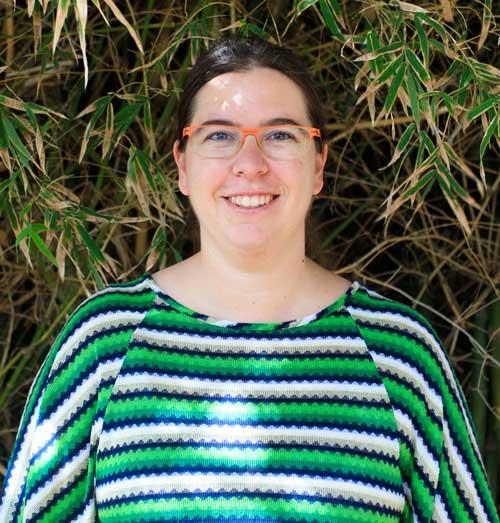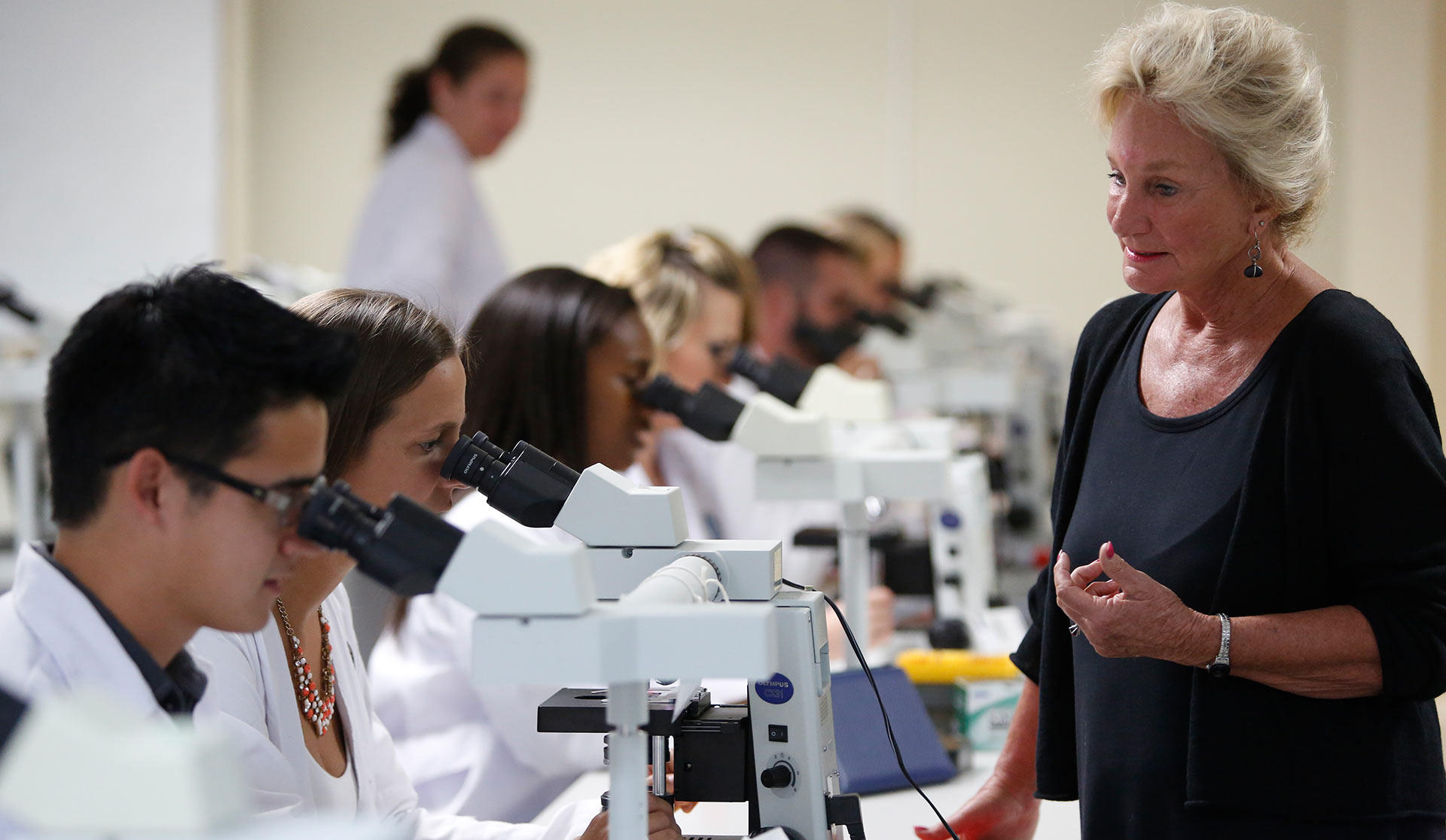
Sarah Hooper, DVM, MS, PhD
Email: Shooper@rossvet.edu.kn
Phone: 869-465-4161 ext 401-1308
Location: Building 2
Room#: 02-006
Dr. Sarah Hooper is a veterinarian, integrative physiologist, and data scientist.. After completing her Doctor of Veterinary Medicine (DVM) degree at the University of Georgia, she was awarded a National Institutes of Health (NIH) T-32 training grant thru the Comparative Medicine Program at the University of Missouri to pursue a residency and PhD. Her doctoral research focused on assessing how dietary components could alter the physiology of the thyroid axis and lead to the development of hyperthyroidism.
With the emerging recognition of seasonal neuroendocrine cycles that affect reproduction, metabolism, and hibernation in bat species, Dr. Hooper was invited to focus on ecophysiology as a Research Fellow with the US Forest Service Northern Research Station where she focused on integrating bat physiological responses and population status into assessments of forest management activities and landscape health. In 2020, Dr. Hooper brought her wealth of knowledge and passion for teaching to Ross University School of Veterinary Medicine (RUSVM). She serves as Course Coordinator for Veterinary Physiology II and actively contributes to courses taught during first and second semester as well as vet prep. In 2023, she became Director of RUSVM’s Research Center for Veterinary, Education, Diversity, and Data Analytics. She is recognized as an emerging leader in veterinary education, spearheading research initiatives related to machine learning and artificial intelligence within veterinary education.
- BSA, Avian Biology, University of Georgia, USA
- DVM, Veterinary Medicine, University of Georgia, USA
- MS, Data Science and Analytics, Biohealth Emphasis, University of Missouri, USA
- PhD, Veterinary Pathobiology, University of Missouri, USA
- Residency, Comparative Medicine, University of Missouri, USA
- Research Fellow, Ecophysiology, USDA US Forest Service Northern Research Station, USA
Dr. Hooper’s transdisciplinary research program focuses on three main areas (1) veterinary medical education, (2) conservation medicine and ecophysiology, and (3) veterinary big data.
Within veterinary medical education, her research revolves around (a) evidence-based, learner-centered, competency-based teaching and learning approaches, (b) educational data mining and learning analytics, (c) simulations, immersive learner experiences, and emerging technologies, and (d) Mental well-being (MWB) and diversity, equity, inclusion, and belonging (DEIB) in veterinary education and the profession.
Within conservation medicine and ecophysiology, her work revolves around (a) understanding the life history and ecophysiology of Chiropteran species, (b) establishing methods using high-resolution mass spectrometry (HRMS) to simultaneously detect and quantify emerging organic contaminants and (c) assess the effects of environmental pollution and pesticides.
Within veterinary big data, her research revolves around (a) disease prediction and prevention in veterinary species, (b) artificial intelligence including large language models (LLMs).
- Chiropteran Conservation
- Conservation Medicine
- Ecophysiology
- Ecotoxicology
- Veterinary Medical Education
- Veterinary Big Data
Hooper, SE, Hecker, KG, & Artemiou, E. (2023). Using Machine Learning in Veterinary Medical Education: An Introduction for Veterinary Medicine Educators. Veterinary Sciences, 10(9), 537. MDPI AG. DOI:10.3390/vetsci10090537.
Hooper SE, Amelon SK, Lin C-H. (2022) Development of an LC-MS/MS Method for Non-Invasive Biomonitoring of Neonicotinoid and Systemic Herbicide Pesticide Residues in Bat Hair. Toxics. 10(2):73. https://doi.org/10.3390/toxics10020073
Hooper, SE. & Amelon, SK. (2022). Pesticide Exposure Risks to Chiropteran Species and the Impacts on Emerging Zoonotic Diseases. In (Ed.), Bats -Disease-Prone but Beneficial. IntechOpen. https://doi.org/10.5772/intechopen.100643
Hooper, SE, Weller, H, Amelon SK.(2020) Countcolors, anR package for quantification of the fluorescence emitted by Pseudogymnoascus destructanslesions on the wing membranes of hibernating bats. J Wildl Dis1 October 2020; 56 (4): 759–767. doi: https://doi.org/10.7589/2019-09-231
Hooper, SE, Weller, H, Amelon SK. Countcolors, an R package for quantification of the fluorescence emitted by Pseudogymnoascus destructans lesions on the wing membranes of hibernating bats. Journal of Wildlife Diseases (accepted)
Hooper, SE, Eshelman, A, Cowan, AN, Roistacher, A, Tyler, P, Amelon, SK. (2020) Using deuterium oxide as a non-invasive, non-lethal tool for assessing body composition and water consumption in mammals. Journal of Visual Experimentation. (156), e59442, doi: 10.3791/59442. PMCID: in-progress
Hooper SE, Backus RB, Amelon SK. (2018) Effects of dietary selenium and moisture on the physical activity and thyroid axis of cats. Journal of Animal Physiology and Nutrition 102:495-504. doi.org/10.1111/jpn.12776 PMCID: PMC5839927
Sprinkle MC, Hooper SE, Backus RC. (2018) Previously undescribed vitamin D C-3 epimer occurs in substantial amounts in the blood of cats. Journal of Feline Medicine and Surgery 20:83-90. doi: 10.1777/1098612X17693523 PMCID: PMC5708158
Pikula J, Amelon SK, Bandouchova H, Bartonicka T, Berkova H, Brichta J, Hooper S, […], Martartínková N. (2017) White-nose syndrome pathology grading in Nearctic and Palearctic bats. PLoS One, 12(8), e0180435. doi: 10.1371/journal.pone.0180435 PMCID: PMC5540284
Hooper SE, Amelon SK, and Womack K. (2017) Bat wing biometrics: using collagen–elastin bundles in bat wings as a unique individual identifier. Journal of Mammalogy 98:744-751. doi:10.1093/jmammal/gyx018 PMCID: PMC5901080
Hooper SE, Korte SW, Giguere S, Fales WH, Davis JL, Dixon LW. (2016) Pharmacokinetics of Ceftiofur Crystalline-Free Acid in Clinically Healthy Dogs (Canis lupus familiaris). Journal of the American Association for Laboratory Animal Science 55:224-229. PMCID: PMC4783643
Kim S, Hooper S, Agca C, Agca Y. (2016) Post-thaw ATP supplementation enhances cryoprotective effect of iodixanol in rat spermatozoa. Reproductive Biology and Endocrinology 14:1-8. Doi: 10.1186/s12958-016-0141-5 PMCID: PMC4731941
Hooper SE, Amelon SK (2014) Handling and blood collection in the little brown bat (Myotis lucifugus) Lab Animal 43:197-199 doi:10.1038/laban.543. PMID: 24845004
For the most up-to-date list of publications visit: https://www.researchgate.net/profile/Sarah_Hooper



